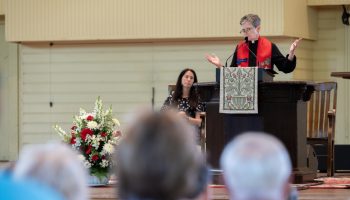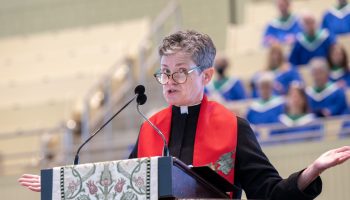“How we frame ‘breaking’ makes all the difference,” said Rabbi David A. Ingber at the 9:15 a.m. Wednesday, Aug. 3 morning ecumenical worship service in the Amphitheater. His sermon title was “Broken Tablets,” and the Scripture reading was Exodus 34:1.
In Mel Brooks’ movie, History of the World, Part 1, Brooks played Moses coming down from Mount Sinai. He has three tablets and says, “Behold I have 15, oy, 10 commandments,” as they fell from his hands.
“It is clear (in the movie) that Moses didn’t break the tablets, they were not thrown in disgust, they just fell,” Ingber said.

In the Scripture, Moses did break them. God said, “… cut two tablets of stone like the former ones, and I will write on the tablets the words that were on the former tablets, which you broke.”
Moses broke them; God says Moses broke them.
“God accuses Moses of breaking the holiest object (in the world), God’s handwritten letter to his people. What was Moses thinking?” Ingber asked.
In the Talmud, the rabbis spent time pondering why God needed to remind Moses he broke the tablets. It seemed cruel to remind Moses he had broken the first set of tablets.
The rabbis played with the Hebrew pointing of the word “ăšer” meaning “that,” and changed it to the word for strength.
“They were playing with the words, teasing, saying ‘Way to go, Moses,’ ” Ingber said. “They were saying, ‘Really? Congratulations on desecrating the sanctity of the tablets.’ ”
“Lishabar” in Hebrew means “to break.” There are many meanings for the words break and breaking.
“We have good breaks and bad breaks,” Ingber said. “We break up and break down; break in and break out; take a break and give me a break; break a leg and you are breaking my back; break even and break rank; break sweat, break away, and morning has broken.”
Ingber asked the congregation how we put a positive spin on breaking.
One way is to read the Scripture passage as congratulations. If the people can make an idol of a calf, what would they do with the tablets? In this view, Moses can be seen as an iconoclast, so that religion doesn’t become ideological.
“We can lose God on the way to heaven,” Ingber said. “We can lose sight of the totality. We can’t see the forest for the trees. Moses broke the tablets so we would not make the Torah into an idol.”
Ingber told the story of a young rabbi who visited a Zen priest who was also Jewish.
“How can you be surrounded by these idols?” the young rabbi asked the priest.
The priest took one of the statues and dropped it out the window.
“Would you do that with the Torah?” the priest said.
The young rabbi became his student.
“Buddhists say, ‘If you meet the Buddha on the road, kill him,’ ” Ingber said. “If you make the Torah, a person, or a place into the thing itself, you are lost.”
He continued, “Every therapeutic insight is breaking the tablets you received. If you have been told you must not do this or that to be loved and be happy, find a teacher who will break the tablets for you.”
The second way to put a positive spin on breaking is to understand “breaking down.”
Psychologist Manfred Halpern, in his book, Transforming the Personal, Political, Historical and Sacred in Theory and Practice, described how four faces of being — political, historical, personal and sacred — are interconnected.
The process of transformation Halpern described has four acts or phases. The first act is emanation, the dying of the certitudes of life. The second act is incoherence, trying to renovate life using the old ways that no longer work. The third act is deformation, which includes acts of violence, racism and terrorism. The last act is transformation, where all four faces of being are liberated to be themselves.
With the breaking of the tablets, Moses started the process of emanation to deformation to transformation.
Rabbi Gamaliel, often regarded as the greatest rabbi of his generation, looked out to sea one day and saw a ship capsizing with Rabbi Akiva, who was viewed as the greatest scholar of his generation, on board.
Rabbi Gamaliel sat on the shore, and as he did, Rabbi Akiva came ashore and began to teach Gamaliel the Torah.
“What brought you here?” Gamaliel asked.
“There was a little plank and I grabbed it,” Akiva said. “Holding on to the fragment brought me to shore.”
“Paradigms shift; nonetheless, something powerful is being born,” Ingber said. “The whole breaks and we begin again. We get lost if we try to make the same thing again.”
The third positive spin on breaking is breaking bread. A rabbi said that “nothing is so whole as a broken heart.” Psalm 51 reads, “The sacrifices of God are a broken spirit: A broken and a contrite heart, O God, thou wilt not despise.”
Ingber told the congregation that there is enormous sadness in the world, but “there is even greater pain when we measure ourselves by the ideal, by what is supposed to be. When the world is counterfactual to what we imagined, we add suffering to suffering.”
In Jewish wedding ceremonies, at the end of the service, the couple breaks a glass.
“We say ‘mazel tov’ when the glass breaks — a strange and weird custom, I know,” Ingber said. “When my family was in a restaurant and the staff dropped dishes, everyone else would look aghast, we would say ‘mazel tov.’ ”
He continued, “All things that are born go through something that breaks. Weddings are beautiful, marriages are messy. Guess what? Love is what happens when glass is breaking. It provides refreshment.”
The patriarch Jacob sent his sons to Egypt, called Mizraim in Hebrew, and the narrow place in English.
“Inside the narrow place, there is nourishment,” Ingber said. “In Genesis, the light that comes from darkness is a revelation. To thrive after suffering is a miracle. There is brokenness before wholeness; we find wholeness in brokenness.”
Kintsugi is the Japanese art of repairing cracks in pottery with gold. Ingber cited an urban myth that the word “sincere” came from a time when masons put wax on the cracks in stones. Customers would ask for stones without wax as “sin cera.”
“Our wounds are our wisdom,” Ingber said. “How beautiful to show our cracks and scars. We wear long sleeves and long pants to cover our scars. We have it backwards. Our scars tell a story. They are our victory, that we have survived. We should wear them like medals.”
There is a crack in every heart. That is how the light gets in.
“What are you going to do with this beautiful Wednesday? What nourishment will you take in?” he asked. “What will you break? What needs to break? Show what hurts, say thank you for this wound — it is part of your wisdom. A broken heart is the most whole thing you will ever have.”
Rabbi Samuel M. Stahl, rabbi emeritus of Temple Beth-El in San Antonio, is the first rabbi to preside at morning worship. Joe Lewis, co-host of the Everett Jewish Life Center and president of the Denominational House Association, read the Scripture in Hebrew and English. Nicholas Stigall, organ scholar, played “Thee Will I Love, My Strength, My Tower,” by Benjamin Culli. Anna Womack, daughter of the Revs. Natalie Hanson and Paul Womack, sang “Anthem,” by Leonard Cohen, for the anthem. Stigall played “Voluntary on CWM Rhondda,” by Albert Travis, for the postlude. Support for this week’s services is provided by the J. Everett Hall Memorial Chaplaincy, the Randell-Hall Memorial Chaplaincy and the Edmond E. Robb-Walter C. Shaw Fund.




